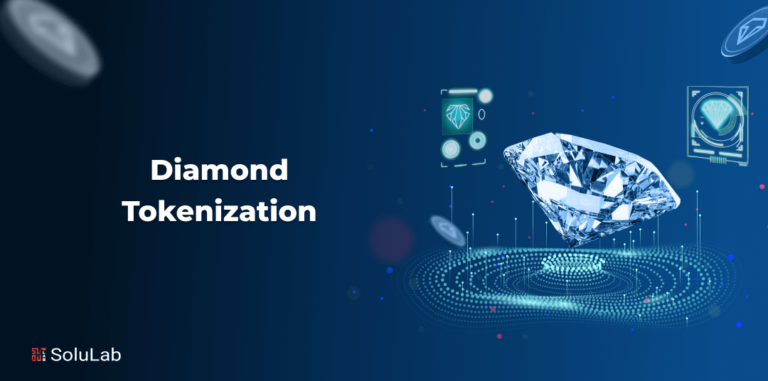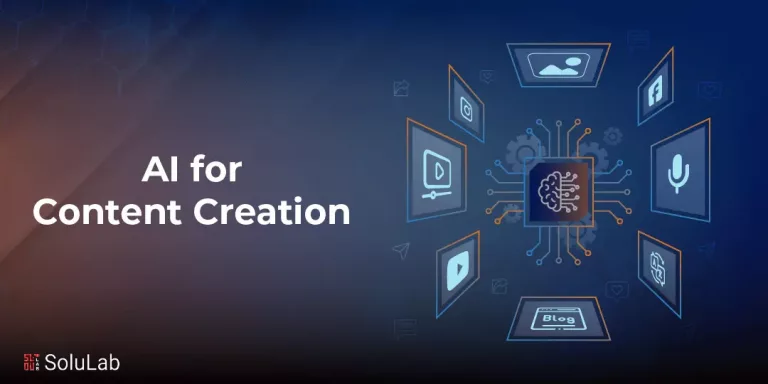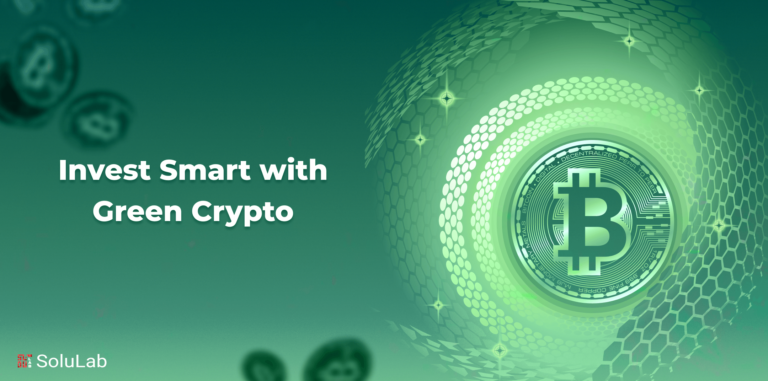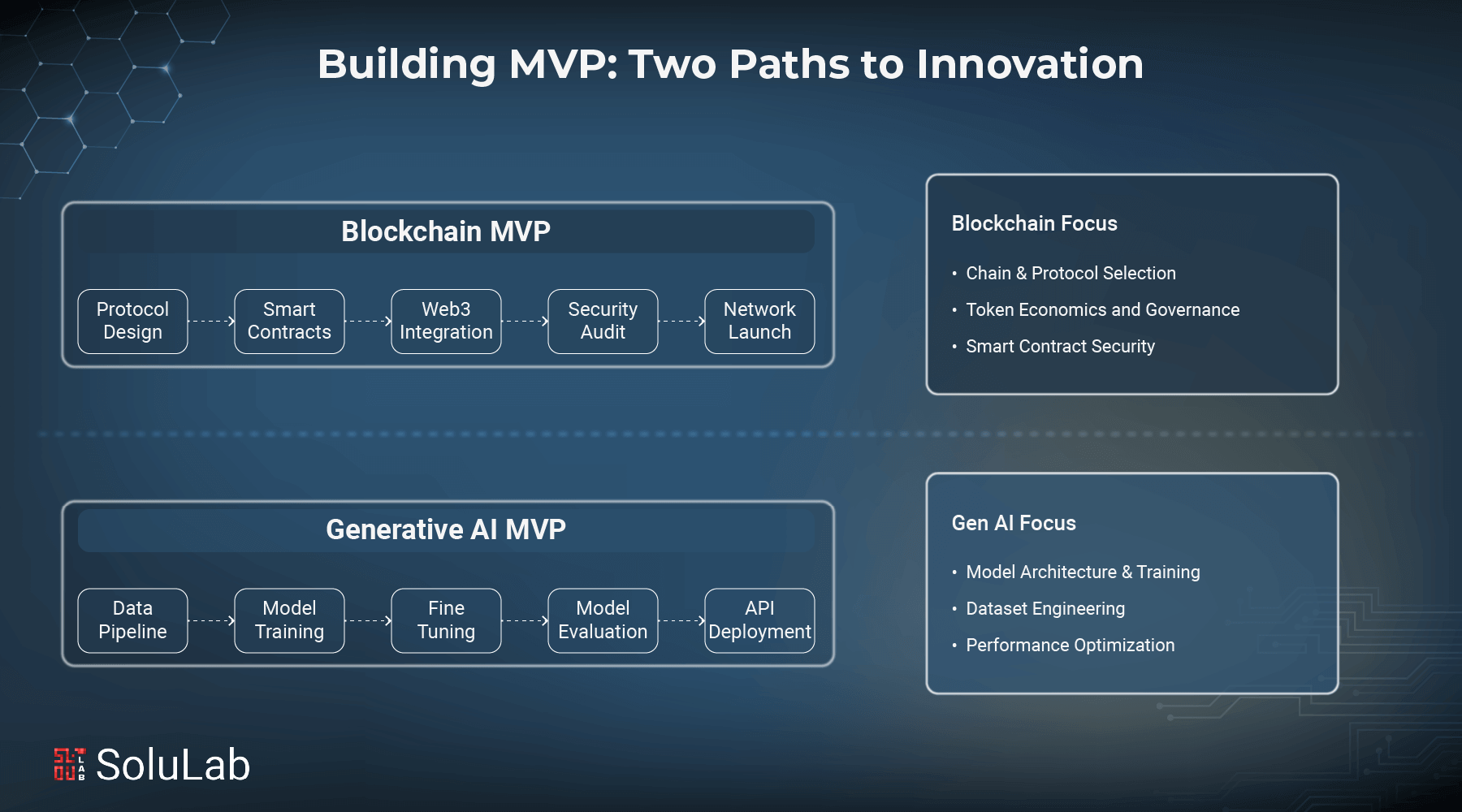
One of the most important phases in creating any Blockchain or GenAI project is building a Minimum Viable Product (MVP). Creating a clear MVP that highlights the important aspects of your product has become even more crucial due to the quick development and use of Blockchain technology.
Many successful tech companies have begun their journey with a basic but brilliant idea: the minimum viable product (MVP). The concept of Dropbox started with just a short video, which explained the concept of file syncing and garnered attention from early adopters before the grand rollout.
The market for blockchain technology was estimated to be worth $92 billion in 2021 and is expected to increase at a compound annual growth rate of 9% from 2022 to 2030, reaching $1,431.54 billion. In this post, we’ll examine the idea of MVP, go over its importance, and offer a comprehensive how-to for creating a successful Blockchain MVP and GenAI MVP.
What Is A Minimum Viable Product (MVP)?
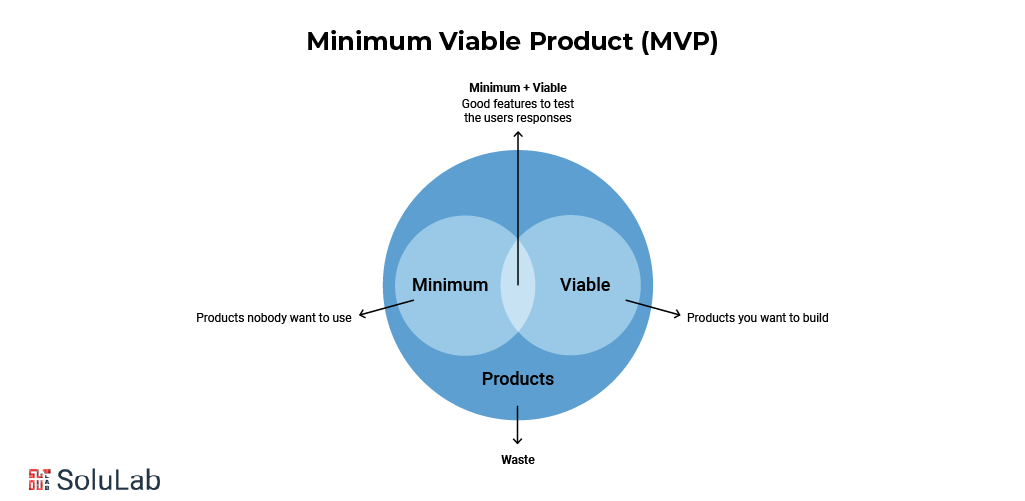
The simplest product iteration that can be made available to test a business concept is called a minimum viable product, or MVP. This idea is a component of the lean startup approach ethos and was made popular by Eric Ries’s book The Lean Startup. With little initial investment, this approach is efficient and learning from client input.
Businesses must strike a delicate balance when creating an MVP: the product must be enough to show its value proposition while remaining simple enough to avoid overcommitting resources. Without the expense of a built product, founders must make sure the MVP accomplishes enough to draw in early adopters and offer information. With this strategy, companies can adjust, learn from input, and move toward a more polished and market-ready product.
Defining MVP in the Blockchain and Gen AI Context
A prototype or early iteration of a product that only has the functionality needed to address a particular issue is called a Minimum Viable Product (MVP). It’s made to gather early user feedback without requiring a significant investment in a finished product.
A simplified version of your AI product that concentrates on its key value proposition with the fewest features possible is called an AI MVP. It saves time and money compared to producing a complete product by enabling you to test your hypotheses and gain from customer feedback early on.
| Parameters | MVP in Blockchain Development | MVP in Gen AI Development |
| Definition | A prototype with core blockchain features to validate feasibility. | A simplified AI product focusing on its key value proposition. |
| Core Focus | Showcasing token systems, smart contracts, wallets, or dApps. | Testing AI capabilities like text generation, image creation, or chatbots. |
| Purpose | Ensures the blockchain concept works before full-scale development. | Validates AI model performance and gathers user feedback. |
| Benefits | Saves development costs while testing decentralized functionality. | Saves time and money by refining AI models based on user insights. |
| Outcome | If successful, it leads to a scalable blockchain product. | Helps optimize AI performance for long-term success. |
Key Features of a Blockchain and Gen AI MVP
In the table below, there are some important features of a minimum viable product made either with blockchain or GenAI:
| Key Features of a Blockchain MVP | Key Features of a GenAI MVP |
| Smart Contracts – A basic blockchain smart contract is included to demonstrate how procedures are automated on the blockchain. | Core AI Functionality – The MVP should have a well-defined AI capability, whether text generation, image creation, or chat assistance, ensuring it efficiently solves a specific problem. |
| Wallet Integration – This function enables users to interact with the blockchain network by sending and receiving tokens or coins. | User-Friendly Interface – A simple and intuitive UI/UX to ensure smooth interactions, even for non-technical users. |
| User Interface (UI) – A straightforward layout that facilitates users’ seamless interaction with the blockchain application. | Customizability & Fine-Tuning – Allow users to tweak the AI’s responses or train it on specific data for better personalization. |
| Security – To safeguard user information and assets from potential threats, security measures are crucial, even in the early phases. | Scalability & API Integration – The architecture should support future expansion and integrate with other platforms via APIs. |
| Consensus Mechanism – Implements a basic consensus protocol to validate transactions and ensure data integrity. | Ethical & Safe Usage – Built-in moderation, bias reduction, and responsible AI guidelines to ensure safe and compliant AI interactions. |
Real-World Examples Of Minimum-Viable Products
Many successful businesses have started from MVPs, which offer a useful way for them to test and improve their business concepts. The following are real-world examples of MVPs:
1. Spotify
Originally developed as a basic technical prototype, Spotify was created to test three key hypotheses: the viability of instant playback from a technical standpoint, the willingness of users to stream music, and to permit for legal streaming. Despite having limited functionality, playing only a few hard-coded tunes, and lacking polish, this early version was essential for confirming the idea. The foundation for Spotify’s future success and development was laid when the team soon discovered that instant, steady streaming was not only feasible but also much wanted by entrusting this basic MVP.
2. Zappos
Zappos was initially an MVP with no inventory, Zappos is now a well-known online shoe retailer. Nick Swinmurn, the company’s creator, merely put images of shoes from nearby retailers on his website and bought them at retail when orders came in. This strategy confirmed that selling shoes online without requiring a big upfront inventory expenditure was a viable business plan.
3. Groupon
In a month, Groupon was started as a two-for-one pizza offer emailed to a 500-person email list following an initial business turnaround. Founder Andrew Mason adds, “The first version was still not pretty.” Nevertheless, the concept proved successful and developed into Groupon’s daily deal model. With the use of this MVP strategy, Groupon was able to gauge consumer interest in group purchasing, which fueled its development in the deals industry.
How To Build And Test Blockchain MVP?
Let’s examine the stages required to create an MVP now that we have a better understanding of its idea and importance in the context of Blockchain development.
1. Identifying the Core Features
Determining the essential features that will be present in the initial release is the first stage in creating a Blockchain MVP. The main problems or difficulties your project seeks to resolve should be addressed by these characteristics. Think about the target market, the demands of the industry, and any special benefits your project may provide. You can deliver a valuable product while saving time and money by concentrating on the essential aspects.
For instance, real-time product tracking, transparent and unchangeable record-keeping, and automated smart contracts for efficient transactions might all be essential components of a Blockchain MVP for supply chain management. These characteristics directly address issues like the lack of visibility and trust that supply chain stakeholders experience.
2. Designing the MVP Blueprint
After determining the essential elements, it’s time to create your MVP’s blueprint. Produce mockups, user flows, and wireframes that give your product a visual representation. The design ought to be simple to use and consistent with your project’s overall branding.
The user experience (UX) is important during the design stage, and the MVP should be simple to use and comprehend. You can get useful and improve the design by analyzing the usability of the design with actual people. For instance, you can get input on the application’s overall flow, button placement, and instruction clarity.
3. Developing the MVP
Now that the framework has been established, development may begin. With the use of technologies and industry, our team of skilled Blockchain developers can assist you in realizing your MVP.
It’s critical to continue working with your development team throughout the development period. Meeting your target audience’s expectations and ensuring the MVP is in line with your vision can be achieved through frequent meetings and updates. Prioritizing the development of the previously selected core functionality is also essential while keeping scalability and future improvements in mind.
By taking these actions, you may create a Blockchain MVP that benefits your users in addition to showcasing the project’s potential. Keep in mind that an MVP is only the start of your and that long-term outcome depends on development based on user input and market demand.
How to Build a GenAI MVP?
Follow this step-by-step guide to build your GenAI MVP:
1. Define Clear MVP Goals
You must have clear objectives for your Minimum Viable Product (MVP) before you can begin your GenAI project. Establish clear goals and begin by identifying the main issue you’re trying to solve. Quick fox Technologies to creating a successful MVP is knowing your target audience and their problems
2. Choose the Right GenAI Tools
Choosing the appropriate tools is essential to completing your generative AI application MVP on schedule. According to Microsoft research, development time can be reduced by up to 70% with the use of appropriate GenAI technologies.
Examine the particular requirements of your project, including the budget, scalability, integration capabilities, and data requirements. For example, Fuzen.io shows how AI and no-code platforms may be combined to save costs and accelerate MVP development. To choose which tool is ideal for your project, consult previous tool breakdowns.
3. Integrate GenAI Into Your Workflow
Planning is essential when integrating GenAI into your workflow. Start by determining areas, such as automating repetitive processes or offering data-driven, where AI can have an immediate impact.
Establish procedures for teamwork with AI systems. This entails using appropriate data management procedures and making certain that everyone is proficient with the selected technologies. After integrating GenAI into your process, you can concentrate on testing and improving your MVP.
4. Test and Iterate
Data should play an important role in testing and improving your MVP. Track user preferences and behavior using AI-powered analytics so you can make well-informed changes.
To continuously improve their MVPs, Microsoft, for instance, uses AI-driven A/B testing and user feedback analysis. By automating testing and analyzing data, GenAI can speed up and improve the accuracy of iteration cycles. This guarantees that your MVP develops in response to actual user needs rather than merely conjecture.
Key Considerations in Blockchain MVP Development
When developing your Blockchain MVP, you should take into account several factors that are essential to the project’s success.
Blockchain technology, which provides unmatched security and transparency, has transformed several businesses. However, there are a few more things you need to think about to make sure your MVP is successful.
1. Security Aspects
The principles of security token offerings, immutability, and transparency are the basis of blockchain technology. Security must t, therefore, be given top priority during the development phase. Put strong security measures in place to safeguard private data and stop illegal access, such as access control, authentication, and encryption.
To further increase security, think about putting multi-factor authentication into place. By doing this, you may protect user accounts and stop illegal access, protecting the integrity of your Blockchain MVP.
2. User Interface
A key factor in the success of any software product, including Blockchain initiatives, is the user interface (UI) and user experience (UX). Your MVP is more likely to be adopted and receive feedback if users can browse and engage with it with ease t, thanks to a well-designed UI/UX.
To learn more about the preferences and expectations of your target audience, think about doing user research. This will enable you to customize your UI/UX design to meet their requirements, creating a smooth and simple user experience. Furthermore, concentrate on developing aesthetically pleasing user interfaces that not only enthrall people but also demonstrate the legitimacy and expertise of your Blockchain MVP.
3. Scalability and Performance
Performance and scalability are important factors to take into account when creating a Blockchain MVP. Large-scale data and transactions may be handled by blockchain technology, but scalability must be considered while designing your MVP.
Plan for future expansion and the capacity to manage higher volumes of data and traffic. To increase scalability, think about using off-chain solutions or sharding strategies. Additionally, make sure your MVP can withstand real-world demands by optimizing performance through the use of caching techniques, effective algorithms, and comprehensive load testing.
GenAI MVP Development Guidelines

GenAI workflow integration is only the beginning. A human-AI relationship is essential to achieving the outcomes.
1. AI and Human Cooperation
Before distributing AI-generated summaries to clients, Morgan Stanley employs a structured review mechanism in which human analysts confirm the information [4]. This guarantees that MVPs are created effectively without sacrificing quality.
Incorporate explicit collaborative techniques, such as the ‘human-in-the-loop’ procedure used by Bonanza Studios. This configuration combines the speed of AI with the accuracy of human oversight, enabling developers to fine-tune AI outputs at crucial points.
2. Standards for Data and Ethics
The success of your GenAI MVP is greatly influenced by the quality of your data. Follow these important guidelines. Impact of Requirement Implementation on Ethics and Data ValidationClear AI guidelines and routine audit promotes user trust.
Protection of Privacy Protocols for data guarantees adherence to GDPR. For instance, safely preserve voice data when developing AI-powered voice assistants. Adhering to these guidelines not only guarantees compliance but also builds user confidence, which is crucial for MVP adoption.
3. Personalizing GenAI Outcomes
Customize GenAI results by modifying models and instructions to achieve certain objectives. Finding the ideal mix between speed and personalization is crucial.
Conclusion
Creating an MVP for your Blockchain or Gen AI project is essential to proving your concept and drawing in investors and early adopters. It enables you to get user feedback while showcasing your product’s key features.
You can increase the likelihood that your project will succeed by following the procedures described in this article and taking into account the important elements of Blockchain MVP development.
SoluLab helped OBORTECH improve its Smart Hub by developing a staking platform, a crypto payment gateway, and smart contracts. These solutions improved interoperability, usability, and scalability, enabling blockchain integration with IoT. As a result, OBORTECH improved transactions, boosted user engagement and ensured secure verification across industries. SoluLab an AI development company has a team of experts to solve your business problems and grow your business. Contact us today to discuss further!
FAQs
1. What are the essential steps to build a blockchain or generative AI MVP?
Identify the problem, define core features, choose the right tech stack, develop a prototype, test with early users, and iterate based on feedback.
2. How long does it take to develop a blockchain or genAI MVP?
The time required depends on complexity, but a functional MVP typically takes 3–6 months. Factors like feature set, team expertise, and testing cycles can influence the development timeline.
3. What are the biggest challenges in building an MVP for blockchain or generative AI?
Key challenges include high development costs, data privacy concerns, user adoption barriers, and ensuring scalability. Additionally, compliance with regulations and optimizing performance for real-world applications can be complex.
4. How can I validate my blockchain or genAI MVP before full-scale development?
Validation involves conducting market research, developing a prototype, testing with real users, and analyzing feedback. This process helps refine features, assess demand, and ensure the MVP aligns with user needs before investing in full-scale development.
5. What technologies are commonly used to build a blockchain or generative AI MVP?
Blockchain MVPs often use Ethereum and smart contract, Hyperledger, or Solana, while generative AI solutions rely on OpenAI’s GPT, TensorFlow, or PyTorch. The choice of technology depends on scalability, security, and the project’s specific requirements.




